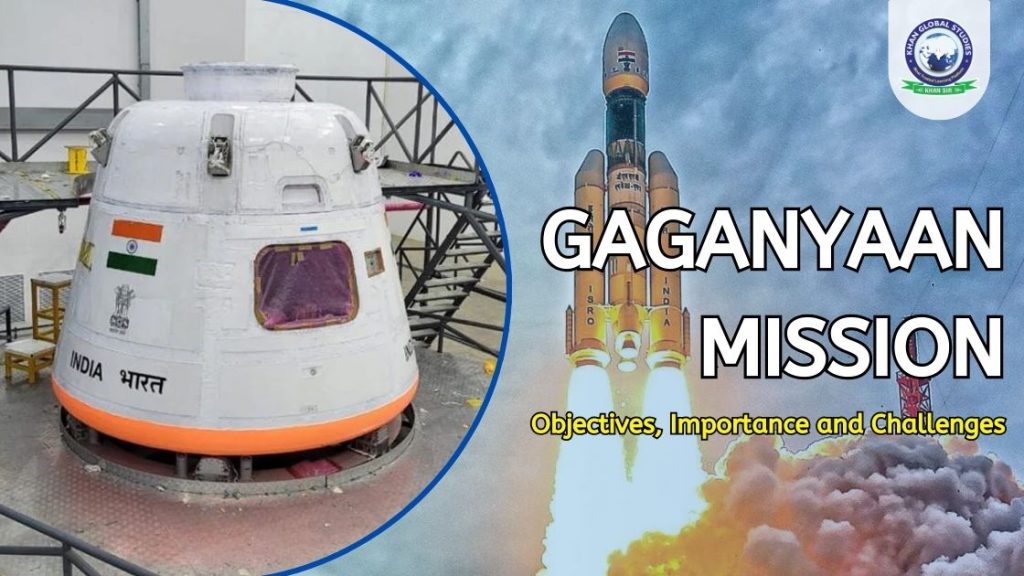For centuries, humans have dreamt of reaching for the stars. In India, that dream is closer than ever with the ambitious Gaganyaan mission, aiming to send the first Indian astronauts into space by 2024. This groundbreaking endeavour marks a historic moment for the nation, signifying its growing prowess in space exploration and technological advancement.
Gaganyaan Mission is India’s ongoing project to send a 3-day manned mission to 400 km low Earth orbit (LEO) with a crew of 3 people and return them safely to Earth. As part of this programme, two unmanned missions and one crewed mission are approved by the Government of India.
The first manned space flight is expected to take place in 2024. The success of the Gaganyaan mission will put India in an elite group of countries (US, Russia and China) with human spaceflight capability.
Reaching for the Sky
Gaganyaan, derived from Sanskrit words for “sky” and “vehicle,” envisions a three-member Indian crew orbiting Earth for up to seven days. The mission encompasses multiple critical steps:
- Developing a Human-Rated Launch Vehicle: The powerful GSLV MkIII rocket will propel the spacecraft carrying the astronauts.
- Building the Crew Capsule: The Orbital Module, designed for space habitation, will provide life support and ensure astronauts’ safety during their journey.
- Training Astronauts: A rigorous selection and training program prepares the chosen individuals for the physical and mental demands of spaceflight.
- Ground Testing and Uncrewed Missions: Before humans embark, unmanned launches will test the capabilities of the launch vehicle and spacecraft.
Objectives of Gaganyaan Mission
Gaganyaan Mission is an ambitious and coordinated project of ISRO in collaboration with various research laboratories, and other agencies like Indian academia and industries with the following objectives:
- Launching human spaceflights: The immediate objective is to demonstrate indigenous capability to launch human spaceflights.
- Space Exploration: In the long run, this will lay the foundation for a sustainable Indian human space exploration programme.
Technologies required for ISRO’s Gaganyaan mission
The program required various precautionary and safety measures to ensure the safety of the crew. In this regard, ISRO required major new technologies for the Gaganyaan mission such as a human-rated launch vehicle, a habitable orbital module, a crew escape system and a life support system.
Human-Rated LVM3
A modified version of ISRO’s most reliable rocket, LVM3 (formerly known as Geosynchronous Satellite Launch Vehicle Mk III), is the launching vehicle of the Gaganyaan mission.
- It has been reconfigured as a human-rated launch vehicle so that it can safely carry humans to the intended orbit.
- It has a three-stage propulsion system – solid stage, liquid stage and cryogenic stage.
- It consists of a solid stage, liquid stage and cryogenic stage with a Crew Escape System (CES) as well as an orbital module.
Orbital Module (OM)
It will orbit the Earth, consisting of a Crew Module (CM) and a Service Module (SM). The Orbital Module is equipped with state-of-the-art avionics systems with sufficient redundancy.
Crew Module (CM):
- It is a habitable place with an Earth-like atmosphere for the crew members on board the ship. It will consist of a human habitable module with control systems, crew communications, navigation, guidance and avionics systems for the mission.
- Structure of the CM: It has a double-wall rigid structure consisting of a pressurized metallic internal structure and an unpressurized external structure with a Thermal Protection System (TPS).
- This includes human-centered products, life support systems, avionics, crew interfaces, and deceleration systems.
- The module is also designed to facilitate re-entry into the Earth’s atmosphere, ensuring crew safety from takeoff to landing.
Service Module (SM):
- It will be used to provide necessary support to the crew module while in orbit.
- It is an unpressurized structure that includes the propulsion system, thermal system, power system, avionics system and deployment mechanism.
Crew Escape System
To ensure the safety of astronauts, various flight abort functions of the Crew Escape System (CES) have been incorporated.
Flight Test Vehicle Aborted Mission-1 (TV-D1):
- This is the first of two aborted missions to test the safety mechanisms and demonstrate the performance of the crew escape system of the Gaganyaan mission.
- It also confirmed the functioning of the system to separate the crew module from the rocket in case of a mid-flight emergency (astronaut abort and escape mission).
- Therefore, this will allow the Gaganyaan crew to leave the spacecraft in case of an emergency.
Life Support System
- To develop life support systems to provide an Earth-like environment to the crew in space, develop crew emergency escape provisions and crew management aspects for training, recovery and rehabilitation of crew members.
Training Program for Gaganyaan Mission Crew Members
- The Astronaut Training Facility set up in Bengaluru provides classroom training, physical fitness training, simulator training and flight suit training.
- The training modules cover microgravity introduction through parabolic flights, aero-medical training, recovery and survival training, crew training simulator, aero-medical training etc.
Various phases of the Gaganyaan mission
ISRO has planned to execute two unmanned missions as part of the Gaganyaan mission projects before the final manned mission due to safety concerns of the project.
- Test Phase: Before carrying out the unmanned and manned missions, ISRO plans to conduct several tests including the following:
- Integrated AirDrop Test (IADT): The objective of this test is to validate the performance of deceleration systems (parachute and pyro) using IAF helicopters.
- Pad Abort Test (PAT): The test will involve dropping the crew module from a helicopter and will help understand the impact from various heights and velocities.
- Test Vehicle (TV) Flights: The test vehicle is a single-stage liquid rocket developed for this aborted mission.
Unmanned mission: This will be for technology demonstration, safety and reliability validation and will carry heavy equipment to study the performance of the systems before crewed flight. Some advanced tests are:
- Airdrop testing for parachute system, flight testing of test vehicle, abort testing for performance.
- Water Survival Test Facility (WSTF): ISRO in collaboration with Indian Navy executed WSTF for initial recovery tests of the Crew Module in February 2023. These tests were part of preparations for the crew module recovery operation.
- Vyommitra: The ‘female’ robotic astronaut humanoid was designed and developed by ISRO to fly on unmanned test missions ahead of the Gaganyaan human space flight mission.
Manned Mission: Gaganyaan’s human space flight module will be followed by two unmanned missions.
More Than a Mission
The significance of Gaganyaan extends far beyond a single spaceflight. It carries crucial implications for:
- National Innovation: The mission fosters cutting-edge technologies in launch vehicles, spacecraft design, life support systems, and astronaut training.
- International Collaboration: Collaborations with global space agencies like Roscosmos and NASA contribute to knowledge sharing and technological advancements.
- Science and Technology Advancement: The mission encourages research in space medicine, materials science, and astrophysics, benefiting various sectors.
- Inspiring the Future: Gaganyaan ignites a passion for science and technology among young Indians, motivating them to pursue careers in these fields.
Importance of the Gaganyaan Mission
The human spaceflight program has many tangible and intangible benefits because of its potential for scientific research and progress. These scientific research and advancements can have far-reaching impacts, benefiting not only India but the entire global scientific community.
- To achieve future technological potential: The success of the Gaganyaan project is expected to inspire affordable human space programs for exploration, sample return missions and other scientific exploration of the Solar System and beyond.
- A unique opportunity to inspire youth: The expected milestones of Gaganyaan will inspire students to pursue careers challenging jobs in science and technology that will encourage innovation and creativity, especially in the field of space science.
- Powerful foreign policy tool: It will open doors for diplomatic cooperation with other spacefaring nations, paving the way for joint missions, exchange of knowledge and international cooperation in space exploration thereby strengthening international partnerships.
- Scientific breakthroughs: Scientific experiments in the microgravity environment facilitated by Gaganyaan can lead to unprecedented discoveries in fields such as medicine, materials science and biology.
- Economic growth and employment generation: The Gaganyaan mission can stimulate economic growth through the development of space-related industries, technology spin-offs and employment generation, which can contribute to the overall development of India.
Challenges related to the Gaganyaan Mission
The challenges associated with a manned mission (Gaganyaan) are much greater than those associated with an unmanned mission. The major challenges faced by space-based missions are space transportation systems, crew safety, and training creation of an Earth-like environment.
- Dependence on Indigenous Technology: The Gaganyaan program is largely dependent on indigenous technology, which requires complex research, development and testing of new complex technology to ensure the safe execution of the programmes.
- Space Transportation Vehicle: While there is a need to send light rockets, heavy rockets are needed to send humans into space. Therefore, the development of optimized launch vehicles capable of carrying large loads from communications satellites is challenging.
- Complex Training and Simulation: India lacks major space training and simulation facilities for manned missions. Hence India’s dependence on other space agencies or countries (America and Russia) for such facilities.
- Regenerative Environment: Due to the limitation of carrying more weight in space, a regenerative environment will have to be developed for food, water, oxygen, carbon dioxide and human waste.
- Creating an Earth-like environment: It is almost impossible to test all the support systems of Gaganyaan in the actual operational environment. Therefore, creating an Earth-like environment inside a small crew module remains a challenging task.
- Crew Security: This is the most sensitive part of the Gaganyaan project. Crews in zero-gravity environments can suffer from depression, radiation exposure, fatigue, sleep disorders, and mental disorders.
The Road Ahead
The Gaganyaan mission faces challenges, including delays, technology development complexities, and budgetary constraints. However, India’s resolve remains unwavering. With continued determination and collaboration, the nation is poised to achieve this historic feat and take its rightful place among the leading spacefaring nations.
FAQs
Question: What is Gaganyaan Mission?
Answer: Gaganyaan is a space mission that showcases ISRO’s human spaceflight capability by launching a crew into a 400 km orbit and returning them safely to Earth.
Question: When was the launch date (first flight) of the Gaganyaan mission?
Answer: 21 October 2023.
Question: Where was the place of Gaganyaan launching?
Answer: Sriharikota Space Centre.
Question: How much does Gaganyaan cost?
Answer: The total cost of the Gaganyaan program is Rs 9023.00 crore.
Question: How high above the Earth does Gaganyaan aim to reach?
Answer: 400 kilometres up in space.
Question: How will the first phase of the Gaganyaan mission be?
Answer: Unmanned.
Question: Who will be sent in the second phase?
Answer: Mission to the robot.
Question: What is the Crew Abort Test Mission?
Answer: An unpressurized version of the Crew Module will be used in the Crew Abort Test Mission. As part of the aborted mission, the crew escape system and crew module will be separated from the test vehicle at an altitude of approximately 17 km.
Question: Where will the crew module land?
Answer: In the Bay of Bengal.
Question: Which company manufactured the crew module?
Answer: Hindustan Aeronautics Limited.
Question: What is the name of the rocket used in the Gaganyaan mission?
Answer: GSLV Mk III, also known as LVM-3, will be used as the launch vehicle in the Gaganyaan mission.
Question: How will the astronauts of the Gaganyaan mission land back on Earth?
Answer: The astronauts will be safely brought back to Earth through a soft landing in the Arabian Sea off the coast of Gujarat.





